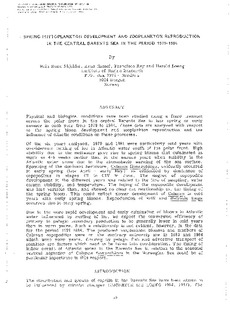| dc.contributor.author | Skjoldal, Hein Rune | |
| dc.contributor.author | Hassel, Arne | |
| dc.contributor.author | Rey, Francisco | |
| dc.contributor.author | Loeng, Harald | |
| dc.date.accessioned | 2008-07-22T08:15:54Z | |
| dc.date.issued | 1987 | |
| dc.identifier.uri | http://hdl.handle.net/11250/107832 | |
| dc.description | The effect of oceanographic conditions on distribution and population dynamics of commercial fish stocks in the Barents Sea. Proceedings of the third Soviet-Norwegian Symposium. Murmansk, 26-28 May 1986. | en |
| dc.description.abstract | Physical and biological conditions have been studied along a fixed transect across the polar front in the central Barents Sea in late spring or early summer in each year from 1979 to 1984, These data are analysed with respeet
to the spring bloom development and zooplankton reproduction and the
influence of climatic conditions on these processes. Of the six years analysed, 1979 and 1981 were particularly cold years with
considerable melting of ice in Atlantic water south of the polar front. High
stability due to the meltwater gave rise to spring blooms that culminated as
much as 4-6 weeks earlier than in the warmer years when stability in the
Atlantic water arose due to the atmospheric warming of the sea surface.
Spawning of the dominant herbivore , calanus finmarchicus , evidently oceurred
in early spring (late April - early May), as evidenced by dominance of
copepodites in stages C1 to CIV in June. The degree of copepodite
development in the different years was related to the time of sarnpiirig, water
coiumri stability, and temperature, The timing of the copepodite development
was less variable than, and showed no clear-cut relationship to, the timing of
the spring bloom. This could reflect slower development of Calanus in cold
years with early spring blooms. Reproduction of krill and Metridia longa
oceurred als0 in early spring. Due to the more rapid development and early culmination of blooms in Atlantic
water infiuenced by melting of ice, we expect the conversion efficiency of
primary to pelagic secondary production to be generally lower in cold years
than in warm years. Such a relationship is not evident, however , in the data
for the period 1979-1984. The produced zooplankton biomass and numbers of
Calanus copepodites were on the contrary extremely low in 1983 and 1984
which were warm years. Grazing by pelagic fish and advective transport of
plankton are factors whieh need to be taken into consideration. The timing of
iriflow events of Atlantic water to the Barents Sea in relation to the seasonal
vertieal migration of Calanus finmarchieus in the Norwegian Sea could be of
partieular importanee in this respect. | en |
| dc.format.extent | 2229403 bytes | |
| dc.format.mimetype | application/pdf | |
| dc.language.iso | eng | en |
| dc.relation.ispartofseries | PINRO-IMR Symposium | en |
| dc.relation.ispartofseries | 3 | en |
| dc.title | Spring phytoplankton development and zooplankton reproduction in the central Barents Sea in the period 1979-1984 | en |
| dc.type | Conference object | en |
| dc.subject.nsi | VDP::Agriculture and fishery disciplines: 900::Fisheries science: 920::Resource biology: 921 | en |
| dc.subject.nsi | VDP::Mathematics and natural science: 400::Zoology and botany: 480::Ecology: 488 | |
| dc.subject.nsi | VDP::Mathematics and natural science: 400::Zoology and botany: 480::Marine biology: 497 | |
